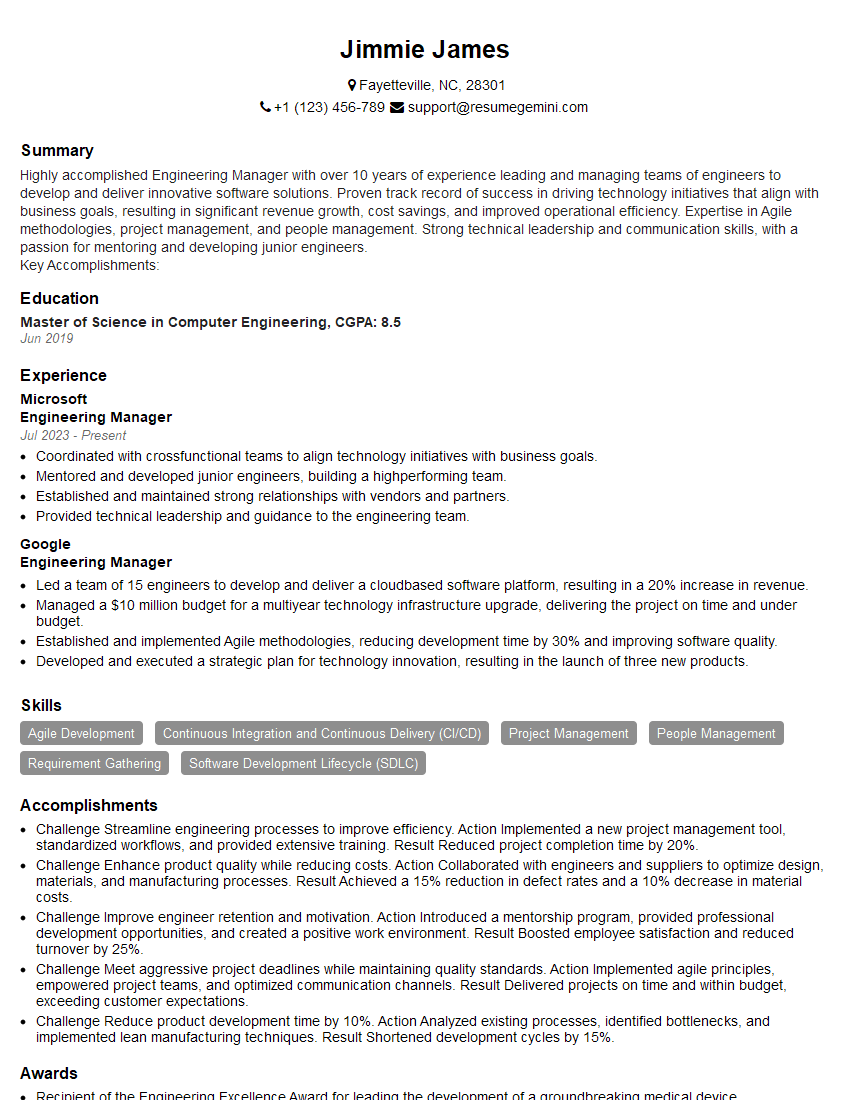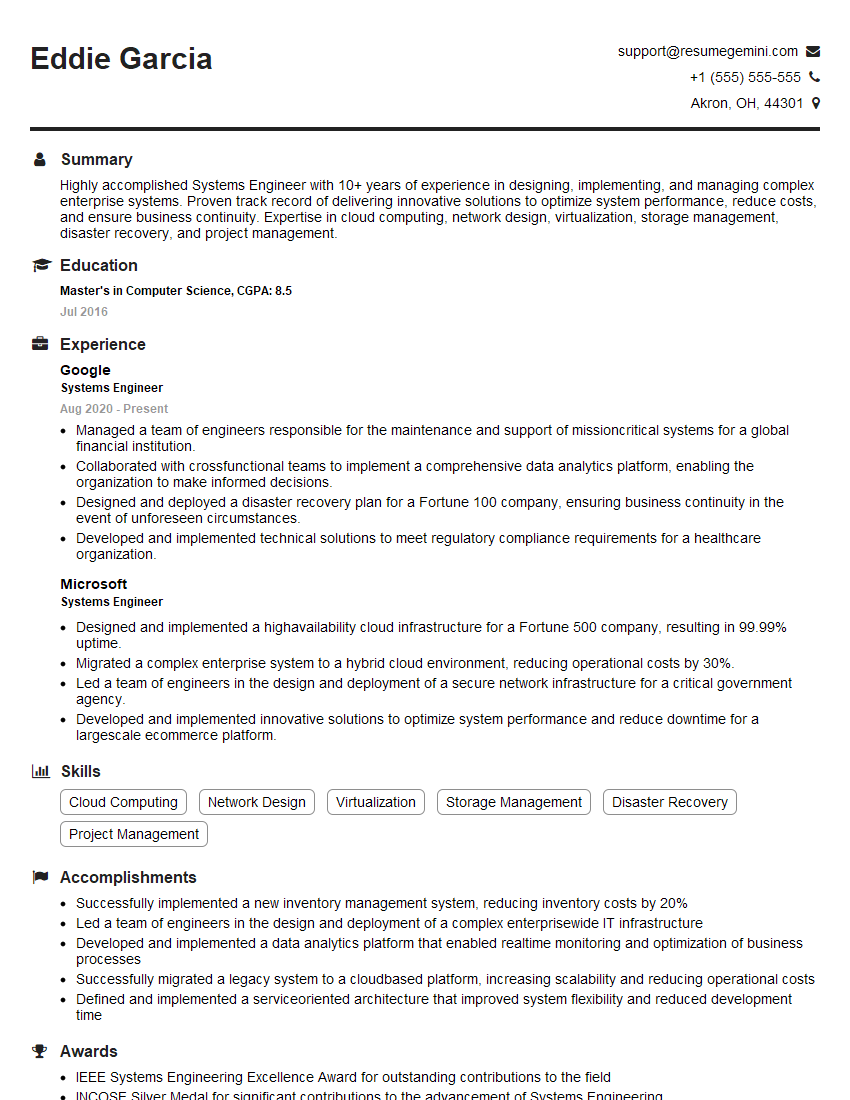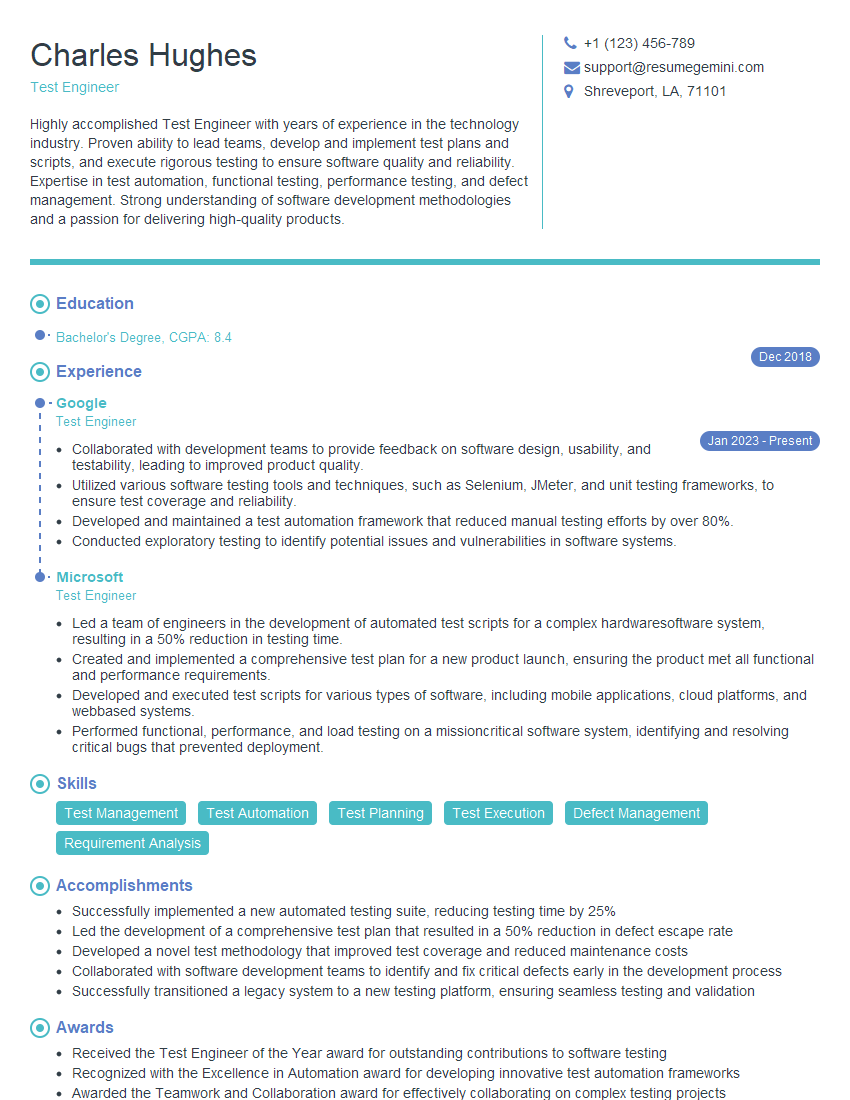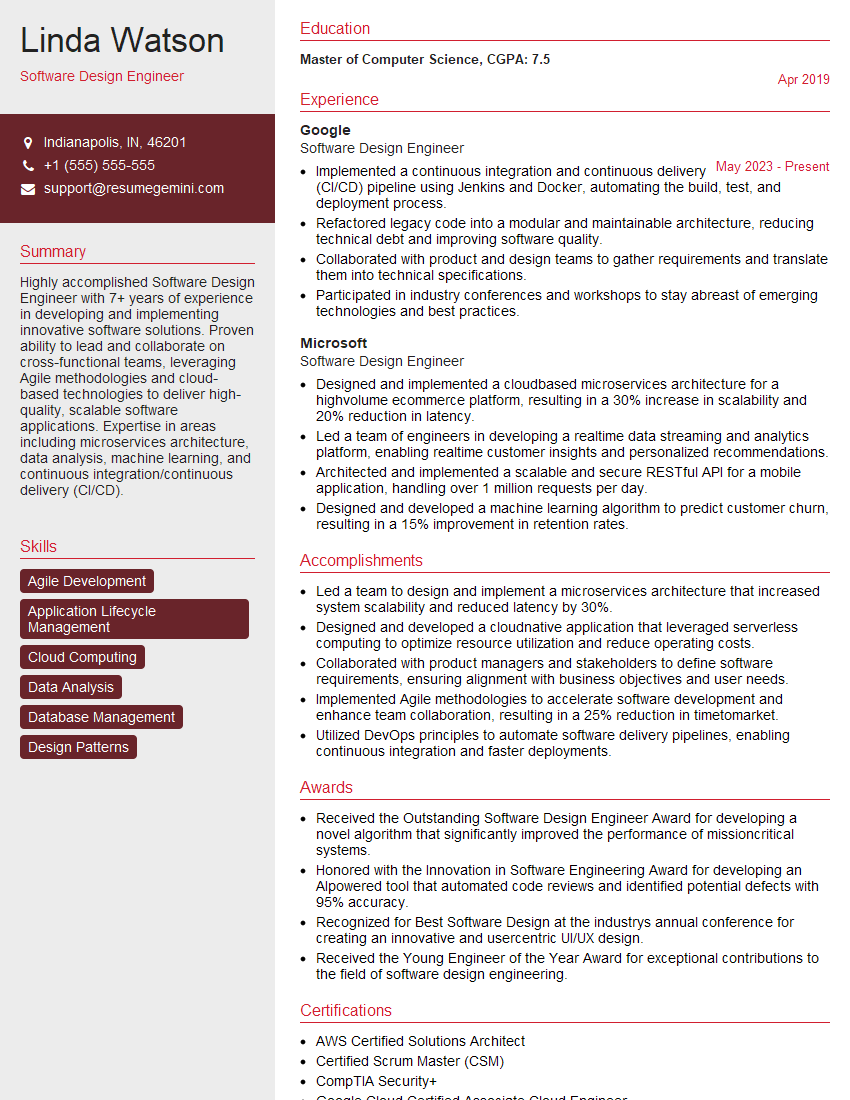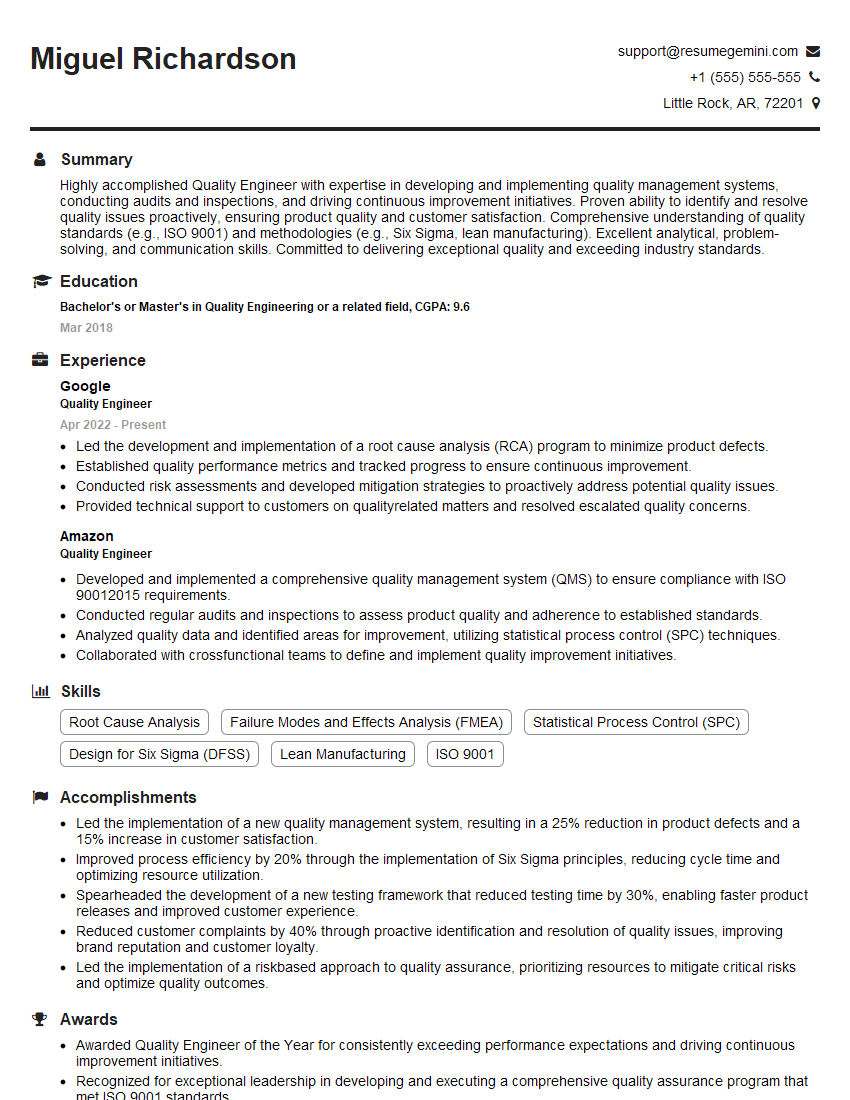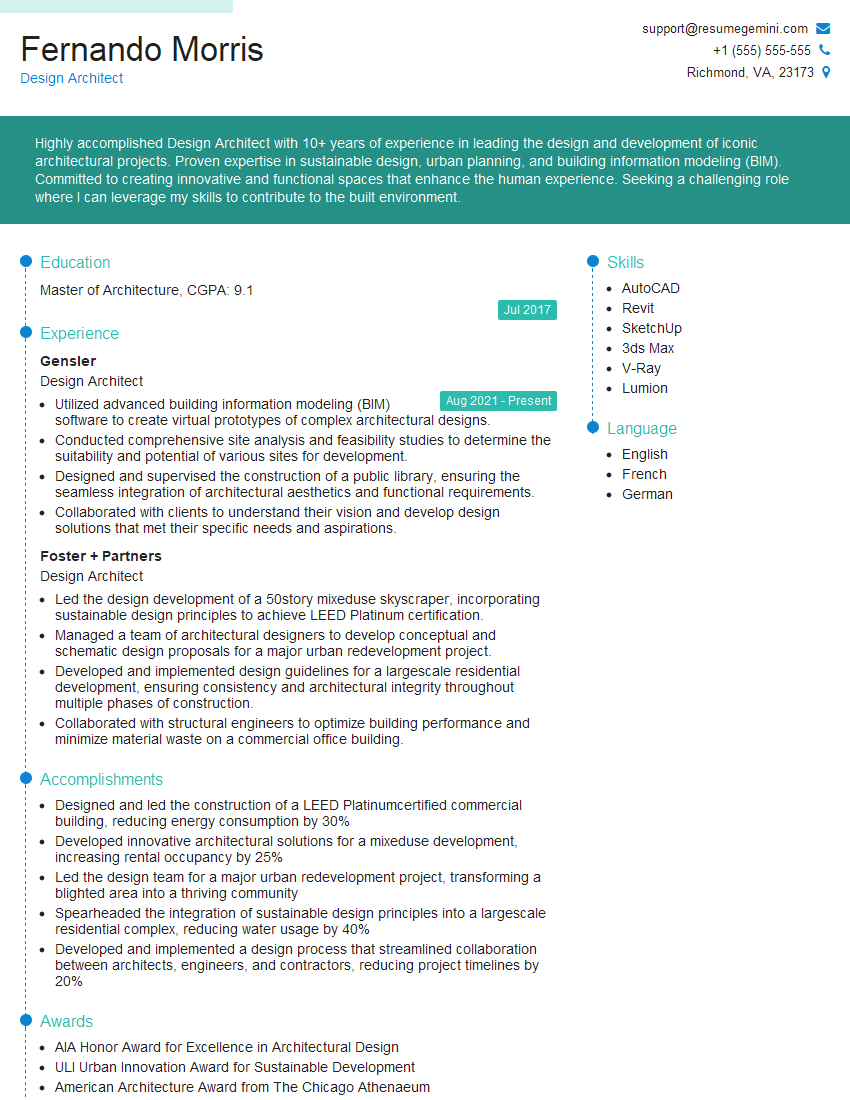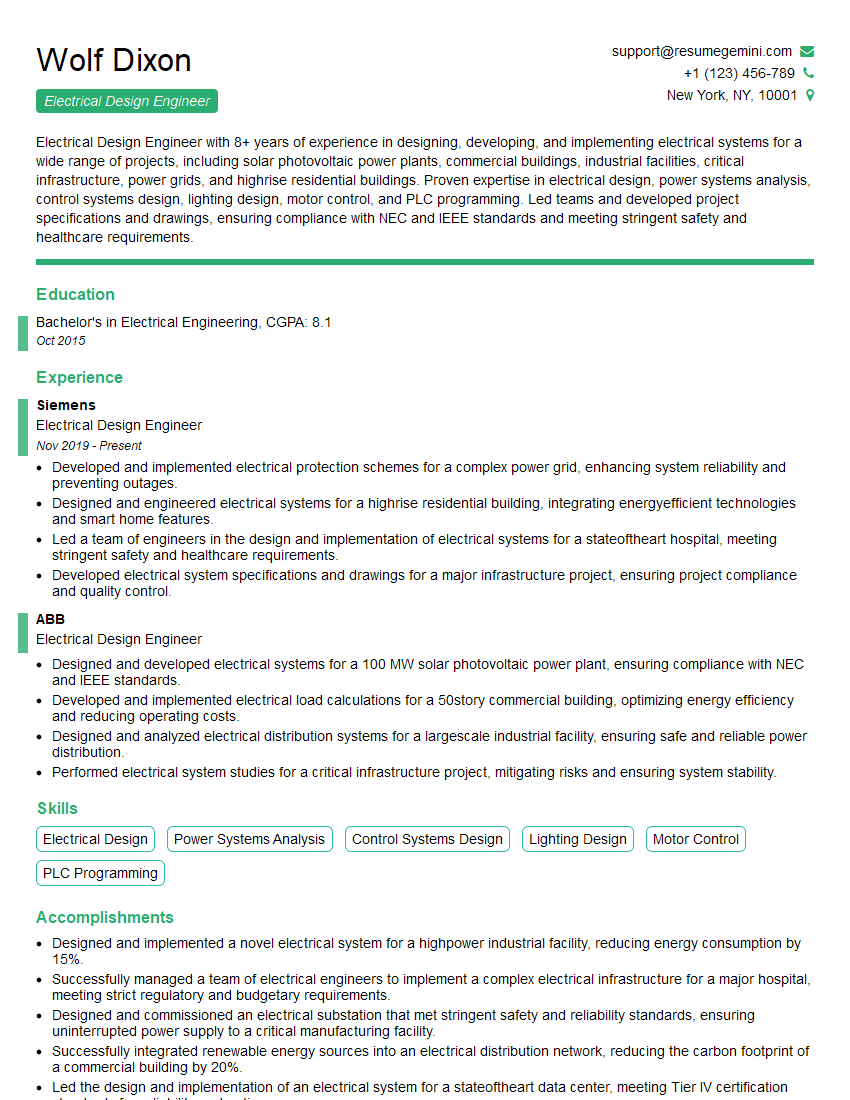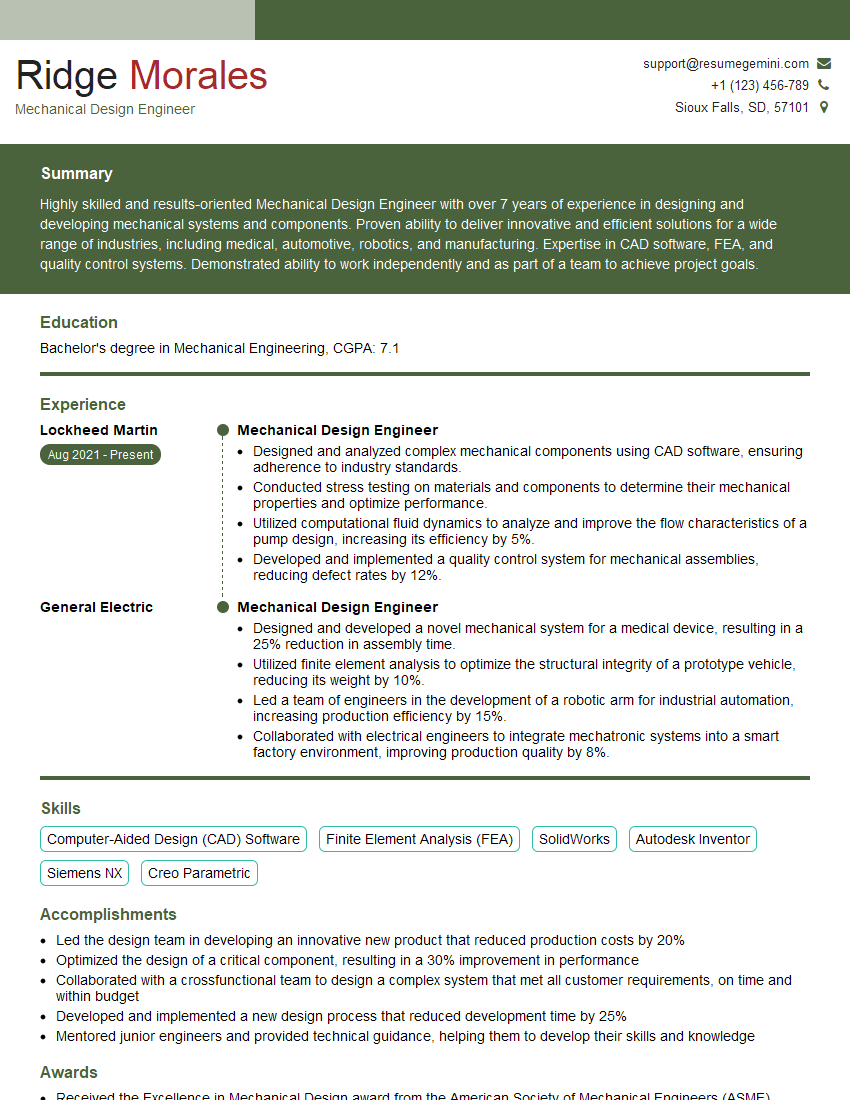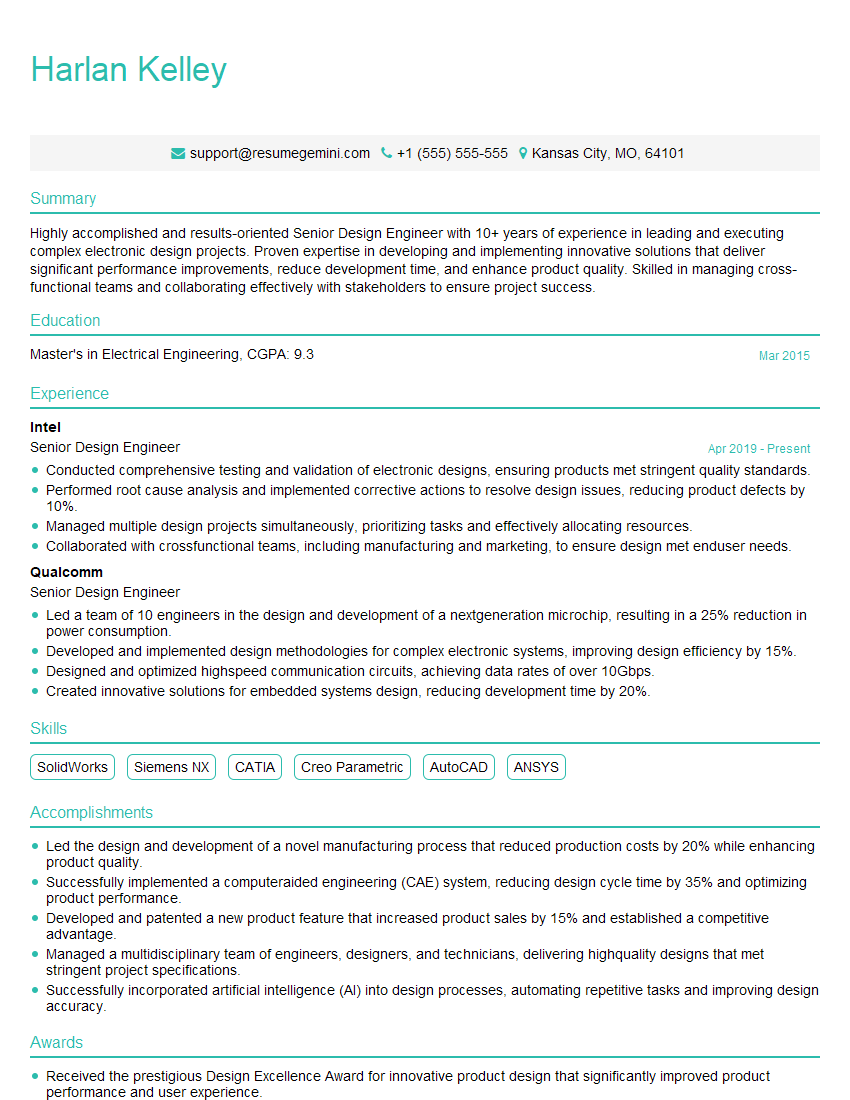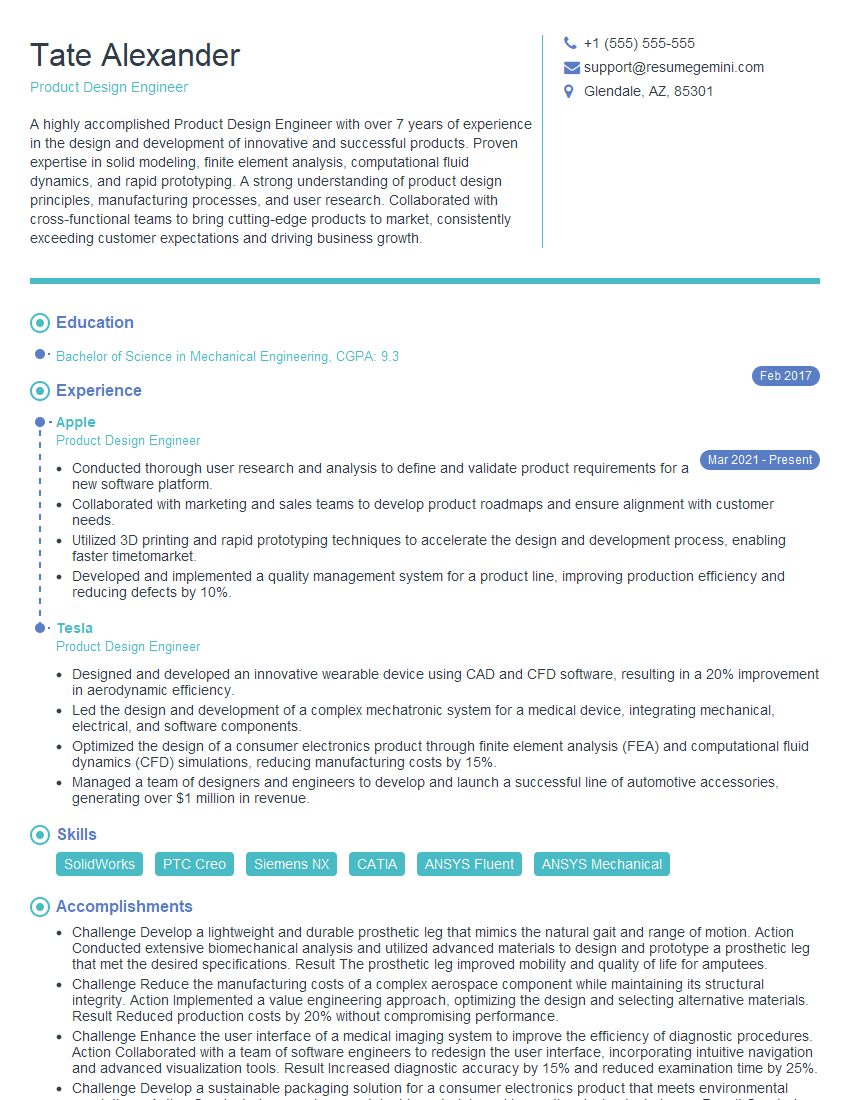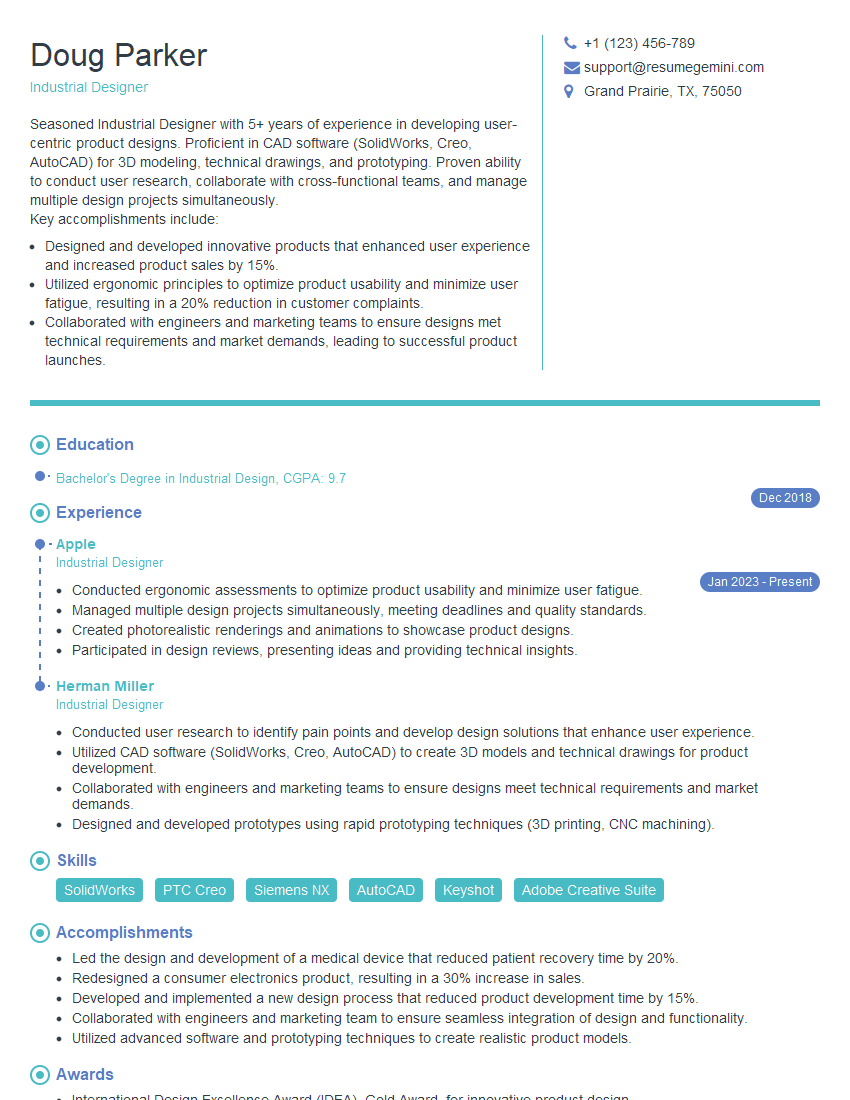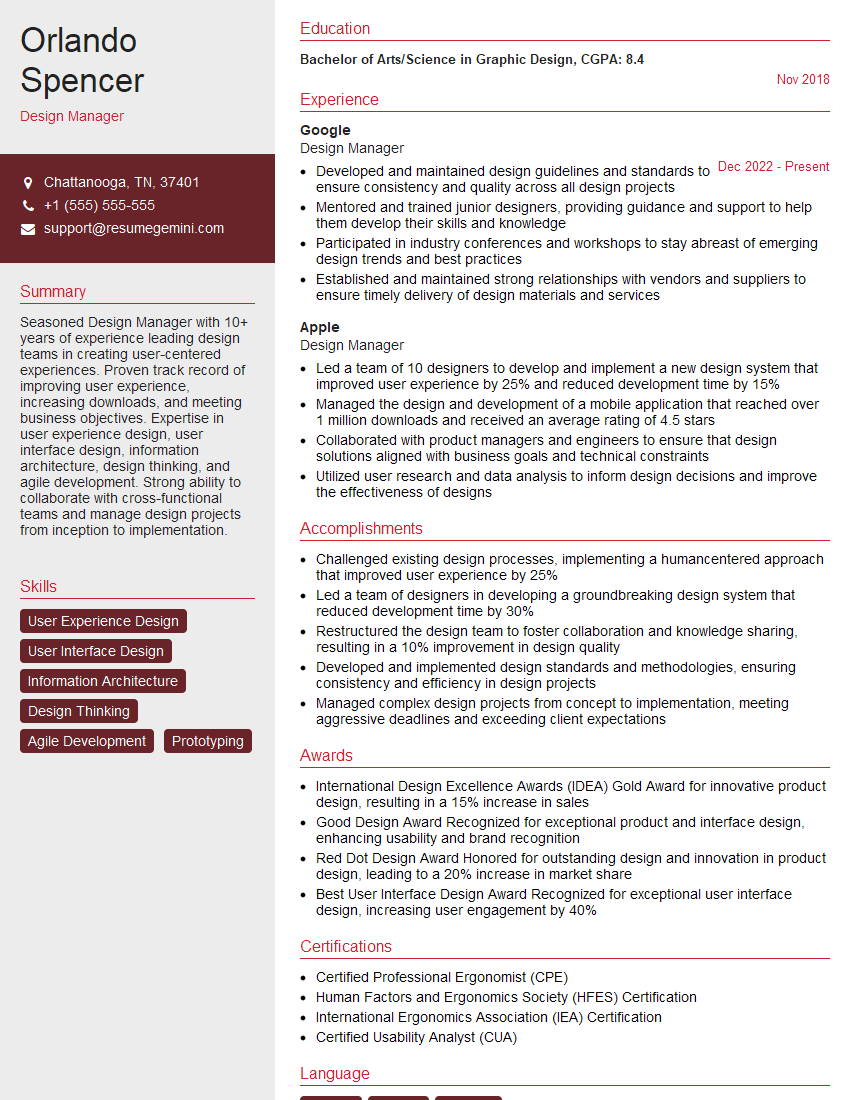The thought of an interview can be nerve-wracking, but the right preparation can make all the difference. Explore this comprehensive guide to Engineering and Design Principles interview questions and gain the confidence you need to showcase your abilities and secure the role.
Questions Asked in Engineering and Design Principles Interview
Q 1. Explain the difference between concurrent and sequential engineering.
Concurrent and sequential engineering represent fundamentally different approaches to product development. Sequential engineering, the older method, follows a linear, waterfall-like process. Each stage—design, testing, manufacturing—is completed before the next begins. Think of it like an assembly line: one step finishes completely before the next starts.
Concurrent engineering, on the other hand, is a collaborative, integrated approach where multiple stages happen simultaneously. Design, testing, and manufacturing teams work together from the outset, constantly communicating and iterating. It’s more like a jazz band—everyone plays their part at the same time, improvising and adapting based on feedback.
Example: Imagine designing a car. In a sequential approach, the design team would finish the complete design before passing it to manufacturing. Any manufacturing issues discovered later would necessitate costly redesigns. In concurrent engineering, manufacturing engineers would be involved from the initial design phase, ensuring the design is manufacturable and cost-effective.
Q 2. Describe your experience with different design methodologies (e.g., Agile, Waterfall).
I have extensive experience with both Agile and Waterfall methodologies. Waterfall, with its rigid phases and sequential nature, is best suited for projects with well-defined requirements and minimal anticipated changes. I’ve used it successfully on projects where the specifications were stable and the risk of significant changes was low, such as the design of a simple, custom-machined part.
Agile, however, is my preferred methodology for most complex projects. Its iterative and incremental nature allows for flexibility and adaptability. The emphasis on collaboration and quick feedback cycles ensures the final product closely aligns with customer needs. In a recent project involving the design of a robotic arm, the Agile methodology allowed us to incorporate client feedback throughout the development process, leading to a much more refined and user-friendly final product. We used Scrum, a specific Agile framework, with daily stand-ups, sprint reviews, and retrospectives to ensure efficient progress and continuous improvement.
Q 3. How do you approach problem-solving in a design context?
My problem-solving approach in design is systematic and iterative. I follow a structured process:
- Define the problem: Clearly articulate the problem, including constraints and objectives.
- Gather information: Research, gather data, and analyze the problem from multiple perspectives.
- Brainstorm solutions: Generate numerous potential solutions, no matter how unconventional.
- Evaluate solutions: Analyze feasibility, cost, time, and other constraints, prioritizing solutions based on a weighted criteria.
- Prototype and test: Develop prototypes to test and refine the chosen solution(s).
- Iterate and refine: Based on testing results, iterate and improve the design until the desired outcome is achieved.
Example: In a recent project involving a failing component, I systematically investigated the root cause – from material properties and manufacturing processes to operating conditions – before proposing a redesigned, more robust version.
Q 4. Explain the concept of Design for Manufacturing (DFM).
Design for Manufacturing (DFM) is a crucial aspect of engineering design that focuses on designing products for optimal manufacturability. It’s about making a product easy and cost-effective to produce. This isn’t just about reducing manufacturing costs; it also includes factors like minimizing waste, improving quality, and shortening lead times. It involves considering the manufacturing process from the outset of the design phase.
Key aspects of DFM include:
- Material selection: Choosing materials readily available and easy to process.
- Component simplification: Reducing the number of parts and simplifying their geometry.
- Assembly considerations: Designing for easy assembly with minimal tooling.
- Tolerance analysis: Specifying tolerances that are achievable and cost-effective.
Example: Designing a plastic part with standardized dimensions and simple features allows for high-volume production using injection molding, reducing costs and increasing efficiency compared to a complex design requiring specialized machining.
Q 5. Describe your experience with CAD software (e.g., SolidWorks, AutoCAD).
I’m proficient in several CAD software packages, including SolidWorks and AutoCAD. SolidWorks is my primary tool for 3D modeling, particularly for mechanical design. I’ve used it extensively for creating detailed models, performing simulations, and generating manufacturing drawings. My experience includes creating complex assemblies, utilizing features like parametric modeling for design optimization and generating detailed drawings for manufacturing.
AutoCAD is my go-to software for 2D drafting and detailed drawings. I’ve used it to create accurate technical drawings, including schematics and plans, ensuring precision and clarity for manufacturing processes and construction purposes. I find both software packages essential tools for creating efficient and high-quality designs.
Q 6. How do you ensure design robustness and reliability?
Ensuring design robustness and reliability involves a multifaceted approach. It starts with thorough upfront design analysis, considering potential failure modes and effects. This includes:
- Material selection: Choosing materials with appropriate strength, durability, and resistance to degradation.
- Stress analysis: Using FEA or other methods to assess stress and strain under various load conditions.
- Tolerance analysis: Accounting for variations in manufacturing tolerances and their impact on performance.
- Testing and validation: Conducting rigorous testing, including fatigue testing and environmental testing to verify design performance.
- Redundancy and fail-safes: Incorporating backup systems or design features to mitigate the effects of potential failures.
Example: In a recent bridge design project, we incorporated multiple layers of redundancy in the structural design, including additional support beams and robust anchoring systems, to ensure stability even under extreme conditions.
Q 7. Explain your understanding of Finite Element Analysis (FEA).
Finite Element Analysis (FEA) is a powerful computational technique used to predict how a product reacts to real-world forces, vibration, heat, fluid flow, and other physical effects. It works by dividing a complex structure into smaller, simpler elements, and then applying mathematical equations to each element to calculate its behavior under the applied loads. The results are then assembled to predict the overall behavior of the entire structure.
FEA is invaluable for predicting stress, strain, deformation, and other critical parameters, helping engineers to optimize designs for strength, durability, and reliability. I’ve extensively utilized FEA in various projects, including stress analysis of mechanical components, thermal analysis of electronic systems, and vibration analysis of structural systems. This analysis provides crucial data that helps prevent premature failure and ensure the safety and reliability of designed products.
Q 8. How do you balance functionality, aesthetics, and cost in design?
Balancing functionality, aesthetics, and cost in design is a crucial aspect of successful engineering. It’s often a delicate dance, requiring careful consideration and prioritization. Think of it like baking a cake: you need the right ingredients (functionality), a pleasing presentation (aesthetics), and a reasonable budget (cost).
Functionality: This refers to how well the design performs its intended purpose. A chair, for instance, must comfortably support a person’s weight and allow for proper posture. This is the non-negotiable aspect.
Aesthetics: This encompasses the visual appeal and user experience. A functional chair can be made aesthetically pleasing through design choices like material, color, and shape. Aesthetics enhance user satisfaction and brand appeal.
Cost: This involves the materials, manufacturing processes, and labor involved. Minimizing cost without compromising functionality and aesthetics requires creative solutions, such as using cost-effective materials without sacrificing quality or exploring alternative manufacturing techniques.
Balancing these three elements often involves iterative design processes. We might start with a highly functional prototype that is then refined to improve aesthetics while maintaining functionality within the budget constraints. For example, in designing a bicycle, we’d first ensure it is structurally sound and cycles efficiently (functionality). Then, we’d work on the frame’s design and color scheme for visual appeal (aesthetics), while using cost-effective, yet durable materials (cost). Trade-offs are sometimes necessary; a highly aesthetic design might cost more, so compromises are carefully considered and documented.
Q 9. Describe your experience with design reviews and feedback incorporation.
Design reviews are integral to my workflow. I’ve been involved in numerous reviews, both presenting my own designs and providing constructive feedback on others’. My approach emphasizes collaborative problem-solving and open communication.
Preparation: Before a review, I meticulously prepare comprehensive documentation, including detailed drawings, specifications, and analysis results. This ensures everyone is on the same page.
Presentation: During the review, I clearly articulate the design’s intent, rationale, and key features, highlighting potential challenges or areas needing clarification. I use visual aids such as prototypes and simulations to enhance understanding.
Feedback Incorporation: I actively listen to feedback, asking clarifying questions to ensure I understand the concerns. I then carefully assess the feedback, determining its validity and feasibility. Feasible feedback is incorporated, sometimes requiring iterations or modifications to the design.
Documentation: All feedback, decisions, and changes are meticulously documented, ensuring design traceability and accountability. This allows for efficient future referencing and troubleshooting.
For instance, in a recent project designing a medical device, initial feedback suggested the user interface was too complex. We incorporated this feedback by simplifying the interface, prototyping the changes, and retesting the usability with potential users, resulting in a much-improved user experience.
Q 10. Explain the importance of material selection in engineering design.
Material selection is paramount in engineering design; it directly impacts the product’s performance, reliability, cost, and sustainability. The choice of material influences virtually every aspect of the design, from its strength and weight to its aesthetic appeal and environmental impact.
Mechanical Properties: The material’s tensile strength, yield strength, hardness, and fatigue resistance are critical for ensuring structural integrity and durability. For example, choosing high-strength steel for a bridge’s support structure is crucial for safety.
Thermal Properties: Consideration must be given to thermal conductivity, expansion coefficient, and melting point, particularly in applications involving heat transfer or temperature fluctuations. Selecting a material with low thermal expansion is important for precision instruments.
Chemical Properties: Resistance to corrosion, oxidation, and degradation is essential in many applications, especially those exposed to harsh environments. Stainless steel’s corrosion resistance makes it ideal for outdoor applications.
Cost and Availability: The material’s cost and ease of procurement are important economic considerations. The availability of the material will also dictate the feasibility of the design.
Sustainability: Choosing environmentally friendly and recyclable materials is increasingly important. This aligns with sustainable manufacturing practices and reduces the overall environmental impact.
A poor material choice can lead to catastrophic failures. For instance, using a material with low fatigue resistance in a component subject to repeated stress cycles could lead to premature failure. Thorough material selection, therefore, demands a detailed understanding of the application’s requirements and the materials’ properties.
Q 11. How do you handle design changes and iterations?
Design changes and iterations are inevitable in any engineering project. They arise from various factors, including new requirements, testing results, feedback, or technological advancements. A systematic approach to managing these changes is crucial.
Change Management Process: I employ a formal change management process to document, review, and approve all design changes. This involves submitting change requests, evaluating their impact, and obtaining necessary approvals before implementation.
Impact Assessment: Before implementing any change, I perform a thorough impact assessment to determine the effect on other design aspects, cost, and schedule. This helps in avoiding cascading effects.
Version Control: Utilizing version control systems (like Git) to track changes is essential for managing multiple design iterations and facilitating collaboration. This ensures that each version of the design is properly documented and accessible.
Testing and Validation: Any changes are thoroughly tested and validated to ensure that they meet the required specifications and don’t introduce new problems. This might involve simulation, prototyping, or physical testing.
For example, during the development of a robotic arm, an initial design proved too complex to manufacture. Through the change management process, we streamlined the design, reducing the number of parts while retaining functionality. Rigorous testing validated the changes before implementation.
Q 12. Describe your experience with prototyping and testing.
Prototyping and testing are fundamental to the design process. Prototypes provide tangible representations of the design, allowing for early identification and resolution of issues before committing to full-scale production.
Prototyping Techniques: I employ various prototyping techniques, including rapid prototyping (3D printing), physical mock-ups, and computer simulations, depending on the project’s requirements and stage of development.
Testing Methodology: Testing involves a systematic approach to evaluate the prototype’s performance against design specifications. This could include functional testing, performance testing, and durability testing.
Data Analysis: Test results are carefully analyzed to identify areas for improvement. This data-driven approach allows for informed design iterations and refinements.
Iterative Process: Prototyping and testing are iterative processes; results from each testing phase inform the next iteration of the prototype.
In a recent project, we used 3D-printed prototypes of a new phone case to assess its ergonomics and user interface. Testing revealed design flaws, such as button placement and material thickness. We corrected these issues in subsequent prototypes, ultimately leading to a superior final design.
Q 13. How do you manage project timelines and deadlines in design projects?
Managing project timelines and deadlines in design projects requires a proactive and organized approach. Effective planning, clear communication, and risk management are crucial.
Work Breakdown Structure (WBS): I use a WBS to break down the project into smaller, manageable tasks, assigning each task a specific timeline. This provides a clear overview of the project’s scope and dependencies.
Gantt Charts: Gantt charts visually represent the project’s schedule, showing task dependencies and durations. This allows for easy monitoring of progress and identification of potential delays.
Regular Monitoring and Reporting: I regularly monitor progress against the schedule, identifying and addressing any delays promptly. Progress reports are communicated to stakeholders to keep them informed.
Risk Management: Identifying and assessing potential risks, such as material delays or design changes, is crucial for proactive mitigation. Contingency plans are developed to address potential setbacks.
Communication: Maintaining clear and consistent communication with the team and stakeholders is paramount. Regular meetings and updates ensure everyone is aligned and informed.
For example, in a recent project, a potential delay in material delivery was identified early. By proactively communicating with the supplier and finding an alternative supplier, we successfully avoided project delays.
Q 14. Explain your understanding of tolerance analysis in design.
Tolerance analysis is a critical aspect of engineering design that involves determining the permissible variations in dimensions and other parameters of a component or assembly. It ensures that the final product functions correctly despite variations in manufacturing processes.
Manufacturing Variations: Manufacturing processes inherently introduce variations in dimensions, tolerances define the acceptable range of these variations. For example, a bolt might have a diameter tolerance of ±0.1 mm.
Statistical Methods: Tolerance analysis often uses statistical methods, such as worst-case analysis and root-sum-square (RSS) analysis, to determine the cumulative effect of individual tolerances on the final assembly.
Design Optimization: The results of tolerance analysis can be used to optimize the design, minimizing the impact of manufacturing variations. This could involve adjusting tolerances, selecting more precise manufacturing processes, or redesigning components.
Software Tools: Specialized software tools are often used to perform tolerance analysis, providing insights into the sensitivity of the design to variations in dimensions and other parameters.
For example, in designing a precision instrument, tight tolerances are crucial to ensure proper functionality. Tolerance analysis helps determine the tightest acceptable tolerances for individual components, balancing manufacturing costs with performance requirements. Incorrect tolerance analysis could lead to a product that doesn’t meet specifications or is prohibitively expensive to manufacture.
Q 15. Describe your experience with design documentation and communication.
Design documentation and communication are crucial for successful engineering projects. Effective documentation ensures everyone involved – from designers and engineers to manufacturers and clients – understands the design’s intent, functionality, and specifications. My experience encompasses creating comprehensive design packages including detailed drawings (using CAD software such as SolidWorks and AutoCAD), specifications documents, bill of materials (BOMs), and assembly instructions. I’m adept at using various communication methods: I’ve presented designs to project teams through technical presentations and reports, and I’ve also collaborated effectively with clients through clear, concise visual aids and written explanations, ensuring all concerns are addressed and everyone is on the same page. For instance, in a recent project involving the design of a complex robotic arm, I created a detailed 3D model accompanied by a comprehensive technical document specifying all component dimensions, material choices, and assembly procedures. This ensured seamless manufacturing and assembly, and minimal discrepancies.
- CAD Software Proficiency: SolidWorks, AutoCAD, Fusion 360
- Documentation Types: Detailed Drawings, BOMs, Assembly Instructions, Technical Reports, Presentations
- Communication Methods: Presentations, Written Reports, Client Meetings
Career Expert Tips:
- Ace those interviews! Prepare effectively by reviewing the Top 50 Most Common Interview Questions on ResumeGemini.
- Navigate your job search with confidence! Explore a wide range of Career Tips on ResumeGemini. Learn about common challenges and recommendations to overcome them.
- Craft the perfect resume! Master the Art of Resume Writing with ResumeGemini’s guide. Showcase your unique qualifications and achievements effectively.
- Don’t miss out on holiday savings! Build your dream resume with ResumeGemini’s ATS optimized templates.
Q 16. How do you ensure the safety and compliance of your designs?
Ensuring the safety and compliance of designs is paramount. My approach involves a multi-faceted strategy that begins with thorough risk assessment. This involves identifying potential hazards throughout the product lifecycle, from design and manufacturing to use and disposal. I utilize various safety standards and regulations (e.g., ANSI, ISO, OSHA) relevant to the project, ensuring all designs adhere to the applicable legal frameworks. I also incorporate design for safety principles like fail-safes, redundancy, and robust material selection. For example, in the design of a pressure vessel, I would carefully calculate maximum operating pressure, choose materials with appropriate pressure ratings, and incorporate pressure relief valves as a safety mechanism. Regular design reviews with colleagues provide a crucial check, catching potential oversights before they become significant issues. Finally, thorough testing and validation are essential to verify that safety features operate as intended and the design performs within the established safety parameters.
- Safety Standards: ANSI, ISO, OSHA
- Design Principles: Fail-safes, Redundancy, Robust Material Selection
- Validation Methods: Testing, Simulation, Design Reviews
Q 17. Explain your experience with sustainability considerations in design.
Sustainability is a core consideration in all my designs. I strive to minimize environmental impact throughout the product lifecycle, from material selection to manufacturing, use, and end-of-life management. This involves choosing eco-friendly materials, reducing waste through efficient design, and optimizing energy consumption. For instance, in designing a piece of furniture, I’d opt for sustainably sourced timber instead of plastics, consider modularity for easier repairs and longer lifespan, and prioritize lightweight designs to reduce transportation energy. Life cycle assessment (LCA) methodologies are also employed to evaluate the environmental footprint of different design options. The aim is to create products that are not only functional and aesthetically pleasing but also responsible and sustainable, contributing to a circular economy.
- Material Selection: Sustainable and Recycled Materials
- Design Principles: Durability, Repair-ability, Modularity, Lightweighting
- Assessment Tools: Life Cycle Assessment (LCA)
Q 18. Describe a time you had to overcome a significant design challenge.
During the development of a small, high-precision instrument, we faced a significant challenge: achieving the required level of accuracy while keeping the device compact and cost-effective. The initial design, while precise, was too bulky and expensive due to the complex mechanism used for positioning. To overcome this, I explored various alternative mechanisms, utilizing finite element analysis (FEA) to simulate and optimize each design. This allowed us to identify and eliminate weak points in the design and predict its performance under different loading conditions. Ultimately, a modified design using a miniature linear actuator and a redesigned linkage system provided the necessary accuracy and precision while significantly reducing size and cost. This involved collaborative brainstorming sessions with the team, iterations of prototypes, and persistent problem-solving. The project taught me the value of exploring alternative design solutions and the critical role of simulation tools in optimizing designs for performance, cost, and manufacturability.
Q 19. How familiar are you with different manufacturing processes?
I have extensive familiarity with various manufacturing processes. My experience includes working with subtractive manufacturing (e.g., CNC machining, milling), additive manufacturing (e.g., 3D printing, selective laser melting), casting, forging, and injection molding. Understanding the capabilities and limitations of each process is crucial for optimizing designs for manufacturability. For instance, I would choose injection molding for high-volume production of plastic components due to its cost-effectiveness, but I might select CNC machining for creating a low-volume, high-precision metal part. I also consider factors such as material selection, surface finish requirements, and tolerance control when selecting the appropriate manufacturing process. This ensures the design is not only functional but also feasible and economical to produce.
- Subtractive Manufacturing: CNC Machining, Milling
- Additive Manufacturing: 3D Printing, Selective Laser Melting
- Other Processes: Casting, Forging, Injection Molding
Q 20. Explain your understanding of ergonomics in design.
Ergonomics is the science of designing workplaces, products, and systems to fit the people who use them. It’s crucial for ensuring user comfort, safety, and efficiency. My approach integrates ergonomic principles throughout the design process, considering factors like anthropometry (human body dimensions), biomechanics (how the body moves), and human factors (psychological and cognitive aspects). For instance, when designing a chair, I would consider the user’s posture, ensuring proper lumbar support and adjustable height. I also account for the reach, force, and frequency of different movements required to operate the product. This often involves consulting ergonomic guidelines and standards and potentially conducting user testing to validate the design’s effectiveness and comfort. A well-designed product not only functions as intended but also minimizes the risk of musculoskeletal disorders and enhances productivity.
- Key Considerations: Anthropometry, Biomechanics, Human Factors
- Design Principles: Proper Posture Support, Reach, Force, and Frequency of Movement
- Validation Methods: User Testing
Q 21. How do you prioritize features in a design?
Prioritizing features in a design is a critical aspect of effective engineering. I typically use a multi-criteria decision analysis (MCDA) approach, combining qualitative and quantitative assessments. This involves identifying all potential features, evaluating their relative importance based on factors like user needs, cost, and feasibility, and then ranking them accordingly. Methods like weighted scoring, pairwise comparisons, and decision matrices can be used to structure this process. The MoSCoW method (Must have, Should have, Could have, Won’t have) is also helpful for categorizing features based on their necessity and impact. For example, in designing a smartphone, essential features like the processor and screen would be prioritized as ‘Must haves’, while features such as a high-resolution camera might be categorized as ‘Should haves’. This structured approach ensures the core functionalities are delivered while managing scope and budget effectively.
- Methods: Weighted Scoring, Pairwise Comparisons, Decision Matrices, MoSCoW Method
- Factors Considered: User Needs, Cost, Feasibility, Risk
Q 22. Describe your experience with risk assessment in design.
Risk assessment in design is a crucial process to identify, analyze, and mitigate potential hazards throughout a project’s lifecycle. It’s not just about preventing accidents; it’s about proactively minimizing disruptions, cost overruns, and project failures. My approach involves a structured methodology, typically incorporating a Failure Modes and Effects Analysis (FMEA) or similar technique.
For instance, during the design of a bridge, I’d consider factors like material fatigue, seismic activity, and extreme weather conditions. An FMEA would list potential failure modes (e.g., cracking of support beams), their effects (e.g., bridge collapse), their severity, likelihood of occurrence, and detection. This helps prioritize mitigation strategies, such as using higher-strength steel or incorporating advanced seismic dampening systems. We’d also consider human factors, like potential errors during construction and maintenance. The process is iterative, incorporating risk assessments at each stage of the design, from conceptualization to implementation and beyond.
Another example involves designing a medical device. Here, risk assessment would focus heavily on patient safety, encompassing biocompatibility of materials, potential malfunctions, and user error. A thorough risk analysis might involve simulations, testing, and rigorous documentation to ensure regulatory compliance and minimize potential harm.
Q 23. How do you handle conflicting requirements in a design project?
Conflicting requirements are inevitable in design projects, often stemming from competing priorities like cost, performance, and aesthetics. My approach focuses on collaborative problem-solving and prioritization. I start by clearly documenting all requirements and their sources. This often involves stakeholder meetings to understand the underlying needs and motivations behind each requirement. Then, I use a variety of techniques to reconcile conflicts.
- Prioritization Matrix: I’d create a matrix to weigh the importance of each requirement against its feasibility. This helps visually identify which requirements are most critical and which are less important or achievable.
- Trade-off Analysis: I carefully evaluate the trade-offs involved in meeting one requirement at the expense of another. This might involve compromises, such as using a less expensive material while still meeting the essential performance criteria.
- Negotiation and Compromise: This is key to resolving conflicts. Open communication and collaboration with stakeholders are necessary to find acceptable solutions that balance various needs.
- Iterative Design Process: I often embrace an iterative design approach where prototypes are created and tested early. This allows us to identify conflicting requirements early on and make adjustments along the way.
For example, during the design of a car, we might face conflicting requirements for fuel efficiency and acceleration. Through trade-off analysis and compromise, we could opt for a lighter-weight design and a more efficient engine, accepting a slight decrease in acceleration for a significant improvement in fuel economy.
Q 24. Explain your understanding of intellectual property rights in design.
Intellectual property (IP) rights in design protect the ownership of creative works and inventions, including patents, trademarks, and copyrights. Understanding these rights is crucial for designers to protect their innovations and avoid infringement. Patents protect novel inventions, including the functionality of a product. Trademarks protect brand names and logos, while copyrights protect the artistic expression in designs, such as the aesthetic appearance of a product.
My experience includes ensuring that designs comply with IP laws, understanding the different types of IP protection available, and collaborating with legal counsel to secure and enforce IP rights when necessary. This includes conducting thorough prior art searches to ensure our designs are novel and patentable. It’s essential to consider IP rights from the initial design stages, documenting design choices, and understanding how to safeguard intellectual property throughout the design process and beyond. Failing to do so can lead to costly legal battles and lost revenue. For example, we meticulously document design changes and keep detailed records of design decisions to build a strong case for patent protection if needed.
Q 25. How do you stay up-to-date with the latest advancements in engineering and design?
Staying up-to-date in the dynamic fields of engineering and design requires a proactive and multi-faceted approach. I leverage various resources to ensure my knowledge remains current.
- Professional Organizations: Active membership in organizations such as ASME (American Society of Mechanical Engineers) or IEEE (Institute of Electrical and Electronics Engineers) provides access to conferences, journals, and networking opportunities.
- Industry Publications and Journals: I regularly read leading journals and industry publications to stay abreast of new technologies, methodologies, and best practices.
- Online Courses and Webinars: Platforms like Coursera, edX, and LinkedIn Learning offer excellent online courses covering a wide range of engineering and design topics.
- Conferences and Workshops: Attending industry conferences and workshops allows me to engage directly with experts, learn about cutting-edge developments, and network with peers.
- Industry Blogs and Websites: Following influential blogs and websites dedicated to engineering and design keeps me informed about the latest trends and innovations.
This continuous learning ensures I apply the latest techniques and technologies, enhancing my problem-solving abilities and project success.
Q 26. Describe your experience with working in cross-functional teams.
I have extensive experience collaborating within cross-functional teams, bringing diverse perspectives and expertise together to achieve common goals. Effective teamwork hinges on clear communication, mutual respect, and a shared understanding of project objectives. My approach involves actively listening to others, valuing diverse viewpoints, and fostering a collaborative environment.
In past projects, I’ve worked with teams including engineers, designers, marketing professionals, and project managers. To facilitate effective teamwork, I often utilize project management tools, such as Agile methodologies, to ensure clear task assignments, regular progress updates, and efficient conflict resolution. I believe that valuing every team member’s contribution is essential, recognizing that individual expertise often complements each other. For example, during the development of a new product, our team involved mechanical engineers, electrical engineers, software engineers, marketing, and manufacturing specialists. The success of the project relied on clear communication and effective collaboration between these disparate teams.
Q 27. How do you measure the success of a design project?
Measuring the success of a design project is multifaceted and goes beyond simply meeting deadlines and budget. I assess success through a combination of qualitative and quantitative metrics.
- Meeting Requirements: Did the design meet its specified functional and performance requirements? This includes technical specifications, usability criteria, and aesthetic goals.
- Cost and Schedule Adherence: Did the project stay within the allocated budget and timeframe?
- User Satisfaction: How satisfied are users with the final design? This is often gauged through surveys, feedback forms, and usability testing.
- Market Success: (If applicable) How well does the design perform in the market? Sales figures, market share, and customer reviews can be key indicators.
- Sustainability and Ethical Considerations: Does the design meet environmental and ethical standards?
For example, in a building project, success might be measured by factors such as energy efficiency, occupant satisfaction, adherence to building codes, and staying on budget. The ultimate goal is to create a design that not only functions well but also enhances people’s lives and respects environmental considerations.
Q 28. Explain your approach to design optimization.
Design optimization aims to improve a design’s performance, cost-effectiveness, or other relevant characteristics while adhering to constraints. My approach is iterative and often employs computational tools and simulations alongside traditional engineering principles.
- Defining Objectives and Constraints: The optimization process begins by clearly defining the design objectives (e.g., minimize weight, maximize strength) and constraints (e.g., material limitations, manufacturing processes).
- Choosing Optimization Techniques: Various techniques are available, such as finite element analysis (FEA) for structural optimization, computational fluid dynamics (CFD) for aerodynamic optimization, and genetic algorithms for complex systems. The choice depends on the nature of the design and the objectives.
- Simulations and Analysis: Computational tools allow us to simulate different design iterations and analyze their performance under various conditions. This often requires constructing detailed models of the system.
- Iterative Refinement: The design is iteratively refined based on the simulation results, gradually approaching the optimal solution. This process often involves trade-offs between competing objectives.
For instance, when designing an airplane wing, we might use CFD to optimize its shape for minimal drag while maintaining sufficient lift. This involves iteratively adjusting wing parameters, analyzing the results, and refining the design until the optimal balance between these competing objectives is achieved.
Key Topics to Learn for Engineering and Design Principles Interview
- Systems Thinking: Understanding how different components interact within a system, including analyzing trade-offs and optimizing performance. Practical application: Designing a sustainable energy system considering environmental impact, cost, and efficiency.
- Design for Manufacturing (DFM): Applying principles of manufacturability to optimize designs for efficient and cost-effective production. Practical application: Choosing appropriate materials and processes to minimize production costs and time.
- Material Selection: Understanding the properties of different materials and selecting appropriate materials based on performance requirements, cost, and environmental impact. Practical application: Selecting materials for a bridge considering strength, durability, and weight.
- Failure Analysis: Identifying and analyzing the causes of failures in engineered systems, including root cause analysis and preventative measures. Practical application: Investigating the cause of a bridge collapse to prevent future occurrences.
- Finite Element Analysis (FEA): Utilizing computational methods to simulate and analyze the behavior of structures and components under various loads and conditions. Practical application: Simulating the stress and strain on a car chassis during a crash test.
- Ergonomics and Human Factors: Designing systems and products that are safe, comfortable, and efficient for human use. Practical application: Designing a user-friendly interface for a complex piece of machinery.
- Sustainability and Environmental Impact: Considering the environmental impact of design decisions throughout the product lifecycle, including material selection, manufacturing processes, and end-of-life management. Practical application: Designing a product with a focus on recyclability and reduced carbon footprint.
- Ethical Considerations in Engineering: Understanding and applying ethical principles in design and engineering practice. Practical application: Considering the potential societal impact of a new technology before its development and deployment.
Next Steps
Mastering Engineering and Design Principles is crucial for career advancement, opening doors to exciting opportunities and leadership roles within the field. A strong resume is your key to unlocking these opportunities. Building an ATS-friendly resume, optimized for applicant tracking systems, significantly increases your chances of landing interviews. We encourage you to leverage ResumeGemini as a trusted resource to craft a compelling and effective resume. ResumeGemini provides examples of resumes tailored to Engineering and Design Principles roles, helping you showcase your skills and experience in the best possible light. Take the next step toward your dream career today!
Explore more articles
Users Rating of Our Blogs
Share Your Experience
We value your feedback! Please rate our content and share your thoughts (optional).
What Readers Say About Our Blog
Hi, I’m Jay, we have a few potential clients that are interested in your services, thought you might be a good fit. I’d love to talk about the details, when do you have time to talk?
Best,
Jay
Founder | CEO
